#1670s Britain
Text

Brown Silk Cloak, 1660-1679, British.
Victoria and Albert Museum.
#cloak#womenswear#extant garments#silk#17th century#1660s#1670s#1660s cloak#1670s cloak#brown#v&a museum#British#Britain#1660s Britain#1670s Britain#1660s England#1670s England
27 notes
·
View notes
Text
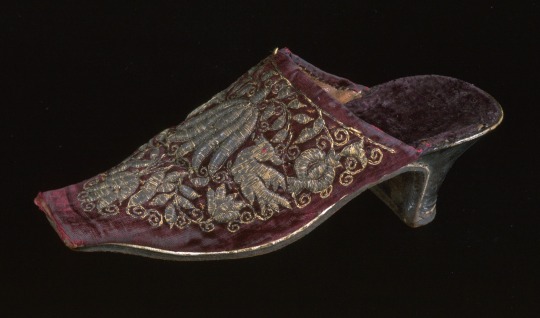


17th century mule shoes;
Women's mule. Velvet, embroidered with raised silver thread, leather heel. England, c. 1650
Mule. Possibly man's, silk, embroidered with raised work in silk and silver thread, leather heel. Britain, 1660s-70s
Mule shoe. Silk and embroidered with raised work in silk and silver thread and leather heel. England, 1660-80
#shoes#mules#costume#17th century#mdpcostume#17th c. costume#footwear#britain#17th c. Britain#1650s#1660s#late 17th century#1670s#mid 17th century
45 notes
·
View notes
Text
Because most medicines were produced from [...] plants [...] these early “pharmaceutical monopolies” required full control of the production and trade of a species. Russia successfully managed the rhubarb trade in the seventeenth and eighteenth centuries, while Spain controlled the distribution [...] from Spanish America, mainly cinchona from Peru, in the same period. “True” cinnamon grew only on Sri Lanka, so whoever controlled the island could dominate the cinnamon trade. The Portuguese were the first to create a monopoly on the cinnamon trade there in the early seventeenth century. That monopoly was later optimized by the Dutch in the late eighteenth century [...].
“True” should indeed be in quotation marks here - the term reflects the historically contingent tastes of Europeans, rather than any botanical category [...]. The rarity of cinnamon in the early modern period made it one of the most coveted spices of that era, and European countries without direct access to the cinnamon trade tried to imitate, substitute, steal, smuggle, or transplant the “true” product from Sri Lanka. [...]
---
In the early modern period, cinnamon was also important both as an exotic commodity and as an important therapeutic substance. The Dutch East India Company (VOC), which controlled Sri Lanka between 1658 and 1796, was well aware of this. The VOC vigorously exploited the Salagama - [...] specialized Sri Lankan cinnamon peelers - to supply enough cinnamon, which for a long time was gathered from forests. Only after the peelers rebelled, leading to a war that lasted between 1760 and 1766, did the company revise its production policy.
Experiments with “cinnamon gardens” (kaneeltuinen in Dutch) led to enormous successes, and the company eventually grew millions of cinnamon trees on plantations in the final decades of the eighteenth century. Meanwhile, competitors of the Dutch had come up with their own solutions [...]: Spain had started growing other Cinnamomum species on plantations in the Philippines, while France and Britain succeeded in transplanting cinnamon to islands in the Caribbean. But the Dutch monopoly was not simply threatened by outside competition. Smuggling, by peelers or VOC personnel, was strictly forbidden and severely punished. [...]
---
Hendrik Adriaan van Rheede tot Drakenstein (1636–1691) was the VOC administrator on India’s Malabar Coast when he started experimenting with cinnamon oil in the 1670s.
He concluded that the oil, which he extracted from the roots of local cinnamon trees, was of better quality than oil from cinnamon trees on Sri Lanka. Van Rheede reported these results in his entry on cinnamon in volume 1 of the Hortus Indicus Malabaricus, the twelve-volume book that was produced by a team of local and European scholars, and supervised by Van Rheede himself.
Van Rheede’s assessment of cinnamon - in fact, the very publication of a multi-volume work about the flora of Malabar - infuriated the governor of Sri Lanka, Rijckloff van Goens, who had secured the cinnamon monopoly of Sri Lanka for the Dutch. Van Goens insisted that Van Rheede stop his medical experiments, claiming that the monopoly was at risk if the cinnamon trade was extended beyond the island of Sri Lanka.
But Van Goens was not so much concerned about the therapeutic efficacy of cinnamon from either of the two regions. He was motivated by an imperial agenda and regarded the natural products of Sri Lanka as superior to anything similar in the region.
The experiments of Van Rheede, who was his former protégé, threatened not so much the botanical quality of the product, or the commercial interests of the Dutch East India Company, but rather the central position of Sri Lanka in the Dutch colonial system and the position of Van Goens as the representative of that system.
---
Even when Sri Lanka still only produced cinnamon that grew in the wild, the Dutch harvested enough to supply an international market and were able to dictate the availability and price level throughout the world. The monopoly, whether defined in commercial or pharmaceutical terms, was not easily put at risk by efforts like Van Rheede’s. Those involved in the early modern cinnamon trade were motivated by various reasons to defend or undermine the central position of Sri Lankan cinnamon: botanical, medical, commercial, or imperial. These motives often overlapped.
---
All text above by: Wouter Klein. “Plant of the Month: Cinnamon.” JSTOR Daily. 17 February 2021. “Plant of the Month” series is part of the Plant Humanities Initiative, a partnership of Dumbarton Oaks and JSTOR Labs. [Bold emphasis and some paragraph breaks/contractions added by me. Presented here for commentary, teaching, criticism purposes.]
150 notes
·
View notes
Text
Who Were the "Hessians"?
A good article from Facebook by Dr Alex Burns;
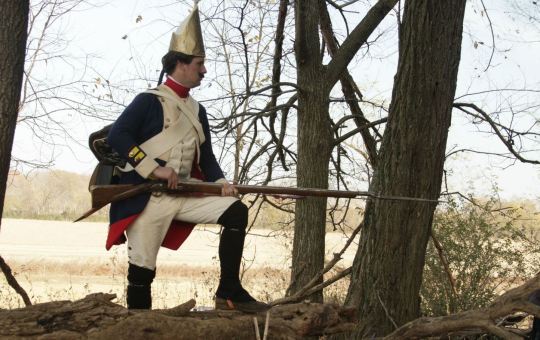
Myth 1): German troops were all Hessians.
Although most came from the mid-sized German state of Hessen-Kassel, troops from six different principalities (Hessen-Kassel, Braunschweig-Wolfenbüttel, Hessen-Hanau, Ansbach-Bayreuth, Waldeck, and Anhalt-Zerbst.) Indeed, the current leading progressive reenactment group portraying these soldiers represents Regiment Prinz Friedrich, essentially a garrison unit from Braunschweig-Wolfenbüttel.
If you include the larger, global war outside America, fought in places like Gibraltar and India, troops from the state of Hanover (Braunschweig-Lüneburg) also fought for the British outside of the Holy Roman Empire (the pre-German territorial entity.) So, while over 60% of these troops came from Hessen, they really hailed from all over the western and central Holy Roman Empire. As a result, it might be better to call them something other than Hessians. "Germanic" has been put forward, but that usually conjures up images of the fall of the Western Roman Empire.
Myth 2): They were mercenaries.
Imagine you are a soldier in the United States Army, serving in West Germany during the Cold War. You are stationed there because of longstanding agreements and alliances, which stretch back decades. The United States Government and the West German government have a financial understanding that helps maintain your presence in the region. Are you a mercenary? The situation was very similar for the German-speaking soldiers who fought in the American War of Independence, They had a longstanding relationship with Great Britain, stretching back decades. They had fought with alongside the British since the 1690s, both in continental Europe and in the British isles. As a result of the Hanoverian succession in 1714 (the British Royal family was drawn from Hanover) they had longstanding marriage connections with Great Britain. Horace Walpole, a British politician from the 1730s, referred to the Hessians as the Triarii of Great Britain.
These soldiers did not personally or corporately take on contracts from the British. they were members of state militaries: their governments were paid a subsidy by the British in order to fight in their wars. Frederick II (the Great) of Prussia, received subsidies from the British during the Seven Years War. As a result, the modern German term for these troops is *Subsidientruppen, *or subsidy troops. **Thus, it might be better to speak of the German-speaking subsidy troops, as opposed to calling them Hessians, or mercenaries. **Historians have argued that it might be fitting to call their countries "mercenary states". This is different from saying they were mercenaries.
Myth 3): They were sold to America because their princes were greedy and wanted to build palaces and pay for their illegitimate children.
The princes of the Western Holy Roman Empire lived in an incredibly dangerous world during the eighteenth century. Their territories were small, rural, principalities, trapped between the military giants of France, Austria, and Prussia. As a result, from the 1670s, these princes attempted to use subsidy contracts to build themselves larger armies, in order to preserve their independence. These subsidy contracts were a standard feature of European politics, diplomacy, and conflict resolution. They allowed the princes to better protect their small domains. None of the princes who formed subsidy contracts with Britain during the American War of Independence were doing something radically new or greedy. Instead, they were following on decades of practice which had allowed them to maintain their own independence. The Hessian (Hessen-Kassel) Landgraf Friedrich II actually used the funds from the contract, in part, to promote economic development and the textile industry in his territories. **Some of them had illegitimate children. Some had palaces. Portraying them as sex-crazed misers limits our understanding of the economic and security necessities which actually underpinned their subsidy policies. **Following the long-standing practices of their governments, princes in the Western Holy Roman Empire entered subsidy agreements to maintain the costs of their states.
Myth 4): They committed many brutal war-crimes in America.
The subsidy troops had been used in messy civil conflicts before. Hessian troops were used against the Jacobites in 1745-6, where they remarkably refused to take part in the repression against the Scottish Jacobites. Their troops were remembered in Perthshire, Scotland, as "a gentle race," and their commanding Prince (Friedrich II) declared, "My Hessians and I have been called to fight the enemies of the British crown, but never will we consent to hang or torture in its name." (Duffy, *Best of Enemies, *p. 133). English officers in the Seven Years War, noted that their troops were reprimanded for plundering more than Hessian forces. (Atwood, *The Hessians, *p. 173). In North America during the War of Independence, the Hessians once again behaved better than their British counterparts. Although there was a surge of fear about Hessian brutality early in the war, after the first few years of the war, Americans believed that the Hessians treated them better than British soldiers. Aaron Burr wrote of Hessian atrocities: "Various have been the reports concerning the barbarities committed by the Hessians, most of them [are] incredible and false." (Matthew Davis, *Memoirs of Aaron Burr, *Vol 1. p. 107). Comparing the brutality of the Napoleonic Wars with the American War of Independence, a Hessian veteran who served in both wars commented: "Everything which the author has subsequently seen in this regard greatly exceeds what one should term cruelty in America, which in comparison with more recent times, can be regarded as nothing more than a harmless puppet show." (Adam Ludwig von Ochs, *Betrachtungen Ueber die Kriegkunst, *60-61.) Hessian troops committed crimes in America, there is no doubt. What is clear is that these crimes were not excessive for an eighteenth-century conflict.
Myth 5): Many of them deserted to America, where life was better.
Many Americans claim Hessian ancestry. As a result, it is common to encounter the sentiment that these "mercenary" troops were simply waiting to switch sides. In reality, most of these troops returned to their homelands in the Holy Roman Empire. A very small number switched sides before the end of the war, a larger (but still small) percentage elected to remain in America after the war ended in 1783. Far from being an act of rebellion, the princes encouraged their subsidy troops to remain in America if they desire: this would cut costs, and make the process of slashing the military budget easier in peacetime. Most returned to celebrations, public parades, and being welcomed by loved ones. For more on exact data of desertions, as well as the subsidy-troops' return home, see Daniel Krebs' book, *A Generous and Merciful Enemy. *The majority of these troops remained loyal to their princes, and returned home to their own native lands.
Who Were the Hessians?
The experience of 37,000 soldiers mainly drawn from six small counties is not all one thing. There are elements of truth to each of the myths about the Hessians, but their story is more complex than the myths that are told about them in English-speaking circles in North America. They were drawn from a fascinating world in Central Europe with its own customs, practices, and traditions. They entered the American story, and as a result, it is worth taking the time to understand and remember their path in it in a complex way.
A "Hessian" Reading List:
Rodney Atwood: "The Hessians: Mercenaries from Hessen-Kassel in the American Revolution"
Friedrike Baer: "Hessians: German Soldiers in the American Revolutionary War"
Stephan Huck: "Soldaten gegen Nordamerika Lebenswelten Braunschweiger Subsidientruppen im amerikanischen Unabhängigkeitskrieg"
Charles Ingrao: "The Hessian Mercenary State: Ideas, Institutions, and Reform under Frederick II, 1760–1785"
Daniel Krebs: "A Generous and Merciful Enemy: Life for German Prisoners of War during the American Revolution"
#history#military history#18th century#american revolution#revwar#american war of independence#hessian#hessians#german
126 notes
·
View notes
Photo

A new sword for the collection that is a significant diversion from my core collecting theme.
Circa the mid-17th Century, this style of sword is unique to the British Isles and was popular from around the time of the English Civil wars (1642 - 1651) up until the 1670s.
The prominent features of the style are a three-bar basket connected to a round pommel by screws. Joining the bars, are usually one or two pairs of crossbars across the front. The top of the hilt is normally a bowl shape with a flat tail at the back. The blades can be either double edged broadswords (like this one) or single edged backswords. In period this likely how they would have been described in armouries or wills.
Also distinctive is the level of decoration that features on the guard, with faces being the most common but not exclusive theme. The meaning behind the faces is lost, but some theories are that it was the Martyred King Charles I. And while this may be true for specific swords, the faces appear on swords with provenance to both sides of the conflict so is unlikely to be true.

To modern collectors and books, these are called Mortuary swords, a name that came into being in the Victorian era. Again, it is not known why, it could be the likeness of the King or that many swords were sold out of Church collections where they had been used for funeral rites. In 1700s it was the practice to donate a soldier’s sword to his church, who would paint them black and put them on display at funerals.
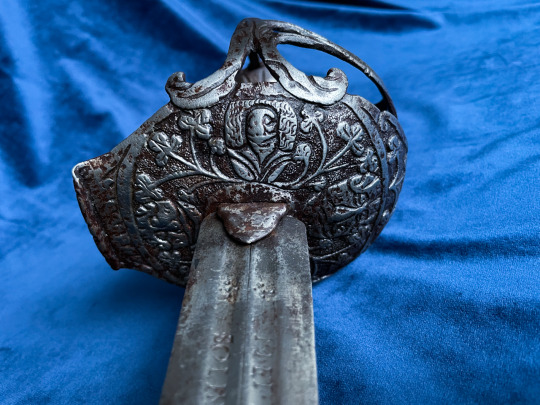
In the 19th Century, many churches were renovating and sold off these swords to interested collectors. Because of the practice of painting the metal, many remained in very good condition.
Typically associated with the cavalry, they were used by infantry as well, although a decorated sword such as this would have belonged to a man of some means. This sword is likely to be an infantry mans’ sword due to its’ lighter weight and shorter length, even if we account for it having lost the point of the blade. Another common modification to swords of this age was the replacement of the grip and wire. Wood does not age as well as steel and it is safe to assume that most 17th Century swords have had the grip re-done. Early collectors and museums looked on artifacts as works of art more than pieces of history, so like a painting restoration, they sought to re-make swords in their image of what they thought it should be.
I believe that this sword possibly came from one such church, as the blade is still stained and there are traces of black finish on the guard. Most of the blades for these swords came from three sources, the English Hanslow smiths, The Low Countries and of course Solingen. However, one cannot go by the markings alone, as forgery was wide spread.
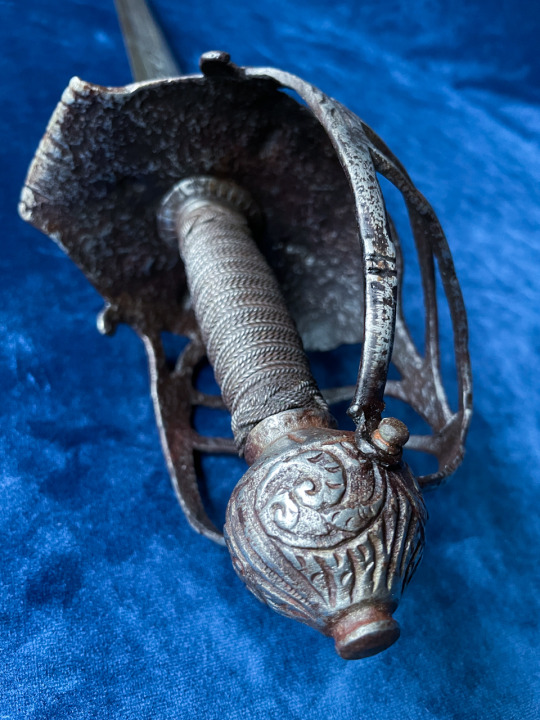
The blade on this sword has several interesting features. It is marked on both sides with the words:
MEFECIT A running Wolf and Tree stamp SAHAGVM
SOLINGEN SAHAGVM
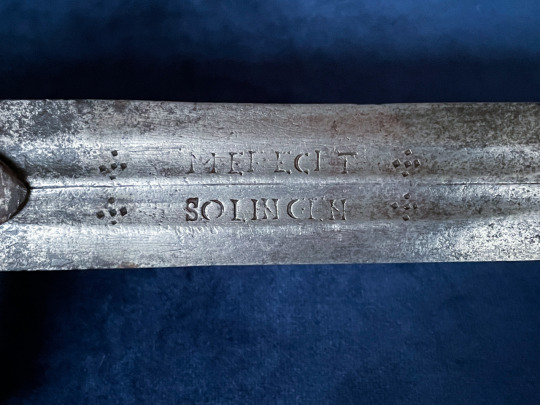


Sahagvm is a reference to Alsonso de Sahagun, el viejo a legendary Spanish
sword smith of the 16th Century. The name features prominently on Dutch ‘Walloon’ swords of the time and is an obvious forgery in line with the ‘Andrea Ferara’ swords of the Scottish Highlanders. Furthermore, the orientation of the wolf in relation to the text is incorrect likely ruling out manufacture in Solingen proper. However, this was a time of trouble, and many families of smiths left their German base to settle in the Low Countries, Britain or further abroad.
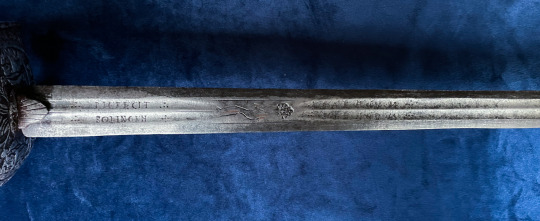
A light sword, the blade specifications are still functional and a close match to those of my 1796 Pattern Heavy Cavalry dismounted service sword with the Andrea Ferara blade.
Overall Length: 992 mm
Blade Length: 830 mm
Grip Length: 146 mm
Inside Grip Length: 100 mm
Weight: 860 grams
Point of Balance: 85 mm
#swords#17th Century#English Civil War#Cavalry#Infantry#Broadsword#Basket-hilt#antiques#military#collection#collecting history
337 notes
·
View notes
Text
The Raid of the Medway, 12–14 June 1667
“And, the truth is, I do fear so much that the whole kingdom is undone”
These were the words of Samuel Pepys Chief Secretary to the Admiralty (1633-1703), taken from his diary entry on 12th June 1667, a stark reminder of the victorious Dutch attack launched on the unsuspecting Royal Navy. This attack became known as the Raid on Medway, a humiliating loss for England and one of the worst in the history of the Royal Navy.
The dates here refer to the Julian calendar used in England at that time.
The Prelude
After the end of the first Anglo-Dutch War in 1654, the restoration of the monarchy had taken place in England with the return of King Charles II (1630-1685). The latter needed financial resources for a government independent of Parliament, which he hoped to gain through the spoils of another war against the United Netherlands. He was supported in this by the ambitions of the Royal African Company to damage the Dutch competition. In the spring of 1665, open warfare broke out. After the initial fighting, the Dutch won the Battle of Four Days in June 1666 and thought they had gained the upper hand. A few weeks later, however, the English fleet regained naval supremacy in the North Sea in the "St. James's Day Fight". As a result, the Royal Navy interdicted Dutch shipping and English captains raided places along the coast. The most famous case occurred on 20 August 1666, when Vice-Admiral Robert Holmes (1622-1692) burned down the village of Ter Schelling on the island of Terschelling and sank 140 to 150 merchant ships anchored in nearby Vlie. This event became known and celebrated in England as Holmes's Bonfire. Afterwards, the English fleet retreated to its own waters.

The raid of the Medway, by Willem van der Stoop (–1665) (x)
War weariness grew in the States General as the costs strained the national budget and confidence in the ally France had waned. After the catastrophic losses of the merchant ships at Terschelling, the Dutch opened peace negotiations under Swedish mediation. But English finances were also exhausted. The war had not brought the hoped-for profits, and Parliament refused to grant new funds for warfare after it emerged that some of the money granted had gone to the king's expensive court. Added to this were the losses caused by the severely impaired maritime trade, the great plague epidemic of 1665 and the "Great Fire of London". Against the opposition of Admiral Monck (1608-1670), King Charles II therefore ordered in the winter of 1666/67 that the large ships of the line be dismantled and decommissioned. The war was to be continued only with privateers in order to damage Dutch trade.
Meanwhile, at the peace congress in Breda, the English envoys had been instructed to reach as advantageous a conclusion as possible. Against the background of the last successes in 1666, Charles II dragged out the negotiations in order to end the war with a profit, even though he had had his only means of pressure, the fleet, de-rigged. The United Netherlands were not prepared to make concessions. Soon, however, they came under pressure from elsewhere. King Louis XIV of France (1638-1715) declared war on the Kingdom of Spain in May 1667 and began an invasion of the Spanish Netherlands to appropriate it. The United Netherlands was now forced to bring peace negotiations with England to an immediate conclusion so that it could concentrate on containing French expansionist intentions. To this end, it seemed necessary to Johan de Witt (1625-1672), the council pensioner and head of Dutch policy, to increase the pressure on England by directly attacking the island of Great Britain.
The Plan
The idea of landing troops on the British Isles was not new. Such plans had already been worked out after the victory of the Dutch fleet in the Battle of the Four Days. In the summer of 1666, Admiral Michiel de Ruyter (1606-1676) had taken about 6000 soldiers to the Thames estuary in addition to the fleet, in order to be able to intervene in a supportive manner in the event of a local uprising of the English population against Charles II. But such an uprising failed to materialise, and the transport ships were sent back to Dutch ports after a storm. Only a brief landing on the Isle of Thanet was achieved.
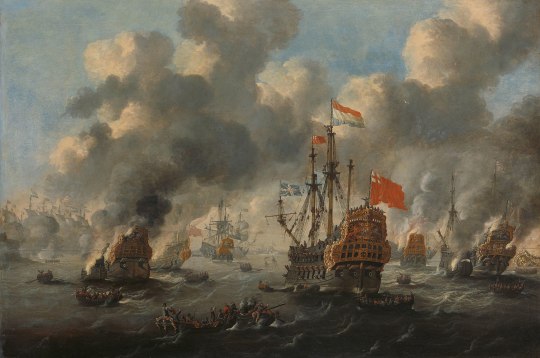
The burning of the English fleet off Chatham, 1667, likely painted by Willem van de Velde the Younger, 1670 (x)
In the summer of 1667, Johan de Witt was well informed by spies about the financial shortages of the English crown and also knew about the decommissioning of most English ships of the line, as well as about the situation of the sailor and dockyard employees who had not been paid for months. Despite his own financial strain, he now prepared the equipment for a Dutch expedition. They were to sail into the Thames Estuary, enter the River Medway and sail to the great dock at Chatham, where many of England's proudest warships lay. Once at their destination, the raiders were to sink or burn as many ships as possible, taking care to capture the best ships as prizes. Such a raid would be a severe blow to the power and prestige of England, for the Royal Navy was the pride of the island nation. Chastened and humiliated by defeat, the English might accept peace on Dutch terms.
The designated contingents of ships were gathered and prepared in various Dutch ports, while in April a squadron under Admiral Van Ghent attempted to enter the Firth of Forth. The main purpose of this enterprise was to provide cover for the main fleet, which assembled at the island of Texel in early June 1667. Admiral de Ruyter sailed along his own coasts, taking in the various contingents as he went. In the end, his fleet consisted of 64 ships of the line and frigates, 15 fireships, 7 escort ships and 13 galliots with a total of 3330 guns and about 17,500 men.
The attack begins
The Assault on Sheerness
The Dutch fleet reached the English coast at Harwich on 7 June 1667. The following day it sailed south along the coast and anchored off the Thames estuary. While doing so, she ran into a storm that forced a large number of ships to cut their anchor ropes and drift. This mainly affected troopships, which were no longer available for the following operations. At a council of war on board the flagship, the further course of action was discussed. Admiral de Ruyter had reservations about sending the entire fleet up the river, as he was not precisely informed about the whereabouts of the smaller English fleet units. Should they return unexpectedly and close the mouth of the Thames, the Dutch fleet would be trapped. Cornelis de Witt proposed that the main force itself should remain off the mouth of the river and a small detachment should guard the English Channel, while a squadron under Admiral Willem Joseph van Ghent (1626-1672) should advance up the Thames. There, this squadron was to attack some West Indian merchant ships at Gravesend, which had been reported by an intercepted Norwegian trader. Admiral van Ghent's squadron consisted of 17 smaller warships, four fireships, some yachts and galiots, and 1000 marines under Colonel Dolman. The squadron set off on the morning of 9 June and initially occupied Canvey Island. However, the wind then shifted and the English merchant ships, which in the meantime had been warned of the approaching Dutch warships, escaped upriver.
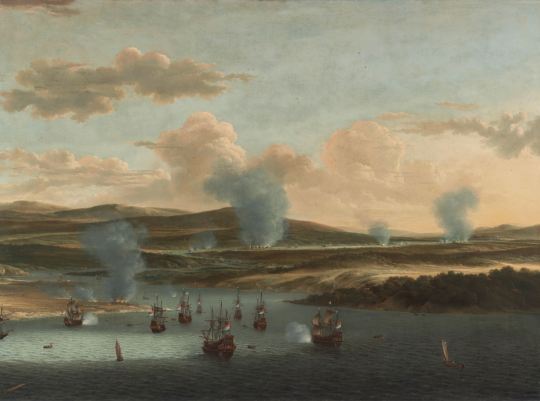
Sail to Chatham, Willem Schellinks, c. 1668 (x)
Cornelis de Witt now urged Admiral van Ghent to enter the Medway and attack the English fleet lying there. The entrance to this river was controlled by a fort still under construction at Sheerness on the Isle of Sheppey. However, to defend this key position, the English had only a weak Scottish garrison, 16 guns, the small frigate Unity and two lightships at their disposal. On 10 June, Admiral van Ghent attacked the fort. The Unity fired only a single broadside and then fled up the Medway, pursued by a Dutch fireship. The Dutch ships took the fort under fire for the next two hours and eventually landed 800 naval soldiers under Colonel Dolman. The fort garrison fled without offering serious resistance to the landing troops and the whole of the Isle of Sheppey was occupied by Van Ghent's forces. The battle for this important position had cost the Dutch about 50 men. The value of the 15 cannons and other goods captured in the process was 400,000 livres or four tons of gold, according to contemporary estimates.

Informed of the events on 9 June, George Monck, 1st Duke of Albemarle (1608-1670) received royal orders to organise the defence. Monck first inspected the installations on the Thames at Gravesend Fort and on the morning of 11 June went to Chatham on the Medway. There he found virtually no organised defence. At Gillingham an iron chain had been drawn across the course of the river, but it was too low. There were only three smaller ships to protect them: the Unity (44 guns), the Charles V and the Matthias (former Dutch merchantmen Carolus Quintus and Geldersche Ruyter). Otherwise, panic reigned. Of the more than 800 dock workers, almost all had fled or refused to help because of their unpaid wages. Out of thirty boats and ships, only ten were still to be found because refugees had used them to escape or local officials had evacuated their personal belongings on them. The Duke ordered the soldiers and officers he had brought with him to set up two coastal batteries on the shore by the chain, but even for this they lacked the necessary tools. To create further obstacles in front of the chain, Admiral Monck ordered fire ships to be sunk there. Two ships, the Norway Merchant and the Marmaduke, were successfully sunk, but the great Sancta Maria, which had also been designated as an obstacle, ran aground. Also on the scene was the large warship Royal Charles (88 guns), but it was completely unarmed.

Stern decoration of the Royal Charles, anonymous, c. 1663 - c. 1664 (x)
Admiral Monck ordered them upriver to safety, but there were not enough personnel to do so. When the Dutch attack came later, she was still lying unmanned on the shore. Among the more than 1100 workers in the docks at Chatham, there were few willing to help. Their pay was months in arrears, as the King lacked the financial means, and now they too refused to serve.
The breakthrough at Gillingham
On the morning of 12 June, the Dutch units began their advance in the Medway. The narrowness of the channel forced the ships to sail one behind the other in a single line. In the lead was the Vrede under the command of her captain Jan van Brakel. The captain had been placed under arrest two days earlier for allowing his men to plunder on the Isle of Sheppey. In order to restore his reputation, he had now voluntarily taken over the top position. Brakel's ship soon came under the crossfire of the three English defensive ships and the two coastal batteries.
However, he steered straight for the Unity without firing and gave her a broadside at point-blank range. The English crew then fled the ship and left it to the Dutch. Under cover of the powder smoke, the two following brander under Brakel's command also approached and sank the English ships Charles V and Matthias in quick succession. The iron chain was subsequently broken during the first ramming attempt (there are some discrepancies in the tradition here, some historians also think that it was simply sailed over because it lay so far in the water and were actually useless).
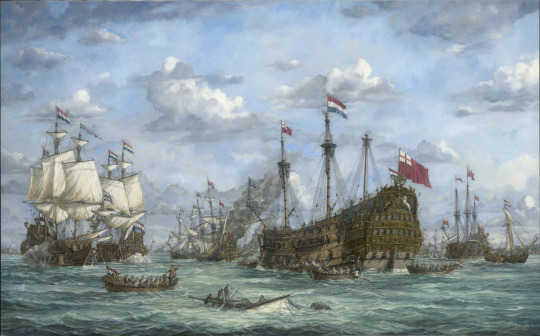
From the left ; "Agatha" , "Beschermer" , "Charles V" , "Propatia" , The "Royal Charles" , "Matthias" and a Dutch Admirals yacht, by Jan de Quelery (x)
The Dutch ships now had free passage up the Medway, because behind the chain there was a wide gap between the sunk English ships, which should have been closed by the sinking of the Sancta Maria. The following Dutch frigates soon silenced the English coastal batteries with their fire, whose fire had been almost ineffective anyway due to structural deficiencies. The biggest prize of the day for the Dutch fleet was the Royal Charles which had often served as a flagship for the English fleet commanders. Btw the Dutch did not take her into naval service because it was considered that she drew too much water for general use on the Dutch coast. Instead the Royal Charles was permanently drydocked near Hellevoetsluis as a public attraction, with day trips being organised for large parties, often of foreign state guests. After vehement protests by Charles that this insulted his honour, the official visits were ended when she was auctioned for scrap in 1673.
Raid at Upnor Castle
Meanwhile, the English were making defensive preparations at Upnor Castle. The Duke of Albemarle and Peter Pett, the commander of the docks, put the castle's guns on standby and set up another battery on the far bank. The attempt to stretch another chain across the river failed. Now they wanted to bring the warships towards Chatham, but again there were not enough men. To at least save the largest warships from capture, the Duke of Albemarle ordered them to be sunk in low water where they could be raised again later.

The Dutch before Upnor Castle, by Jan de Quelery (x)
Late in the afternoon of 12 June, the Dutch advance was halted by the state of the tide. On board the captured Royal Charles, Van Ghent, De Ruyter and De Witt met to discuss further action. These three commanders decided to push further upriver the following day and attack the Chatham Dockyards and the large warships located there. At midday on 13 June, the remaining Dutch braders, protected by four frigates and a larger number of smaller ships, attacked the English positions. They were soon caught in the crossfire between Upnor Castle and the battery hastily raised on the opposite bank of the river. A detachment of naval soldiers landed and moved to attack the English ammunition magazine at Upnor Castle, which they successfully blew up before withdrawing again.
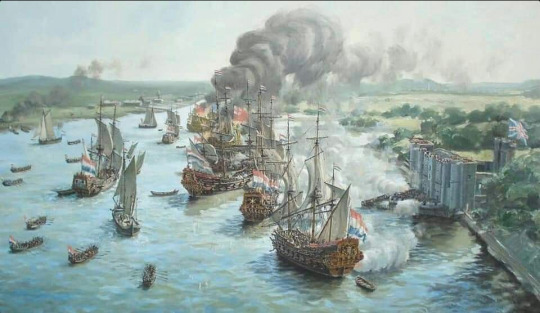
The bombardment of Upnore Castle by Arnold de Lange (x)
In the meantime, the Dutch ships fired on the English gun batteries. While the battle was still going on, a calm set in, forcing De Ruyter and other officers to transfer to longboats in order to direct the actions of their units from them. After a fierce firefight, the Dutch fireships succeeded in attacking the three large warships lying on the shore, Loyal London (92 guns), Royal Oak (76 guns) and Royal James (82 guns). The water in which these ships had been sunk by the English themselves was not shallow enough to offer protection even against an arson attack. All three ships fell victim to the Dutch fireships after their hull crews fled. The Duke of Albemarle, meanwhile, tried to tow the remaining warships upriver under the protection of Chatham's guns. He lined up battle-ready warships on the banks and gathered militia troops to halt the Dutch advance. In fact, the Dutch ships went no further against the stiffening English resistance. Late in the afternoon they retreated with the rising tide as far as Gillingham. There they made the captured English ships Royal Charles and Unity seaworthy and left the Medway on 14 June. The losses from the battle in front of Upnor Castle amounted to about 500 men on the English side, while it is assumed that the Dutch lost between 50 and 150 men.
The aftermath
The Dutch raid on the English ships in the Medway became the biggest debacle of the war for the Royal Navy. It lost more ships than in all previous naval battles combined. The Royal Charles and the Unity had been captured by Dutchmen and the Loyal London, Royal James, Royal Oak, Charles V, Matthias, Marmaduke, Sancta Maria as well as five fireships, two ketches, a fleute and a smaller ship sunk or burnt. In contrast, the Dutch had deployed a total of ten fireships. In addition, there were further indirect losses of the Royal Navy. The Vanguard, for example, had drifted while attempting to ground her and eventually wrecked at Rochester so that she could no longer be lifted. Further north, beyond Gravesend, Prince Rupert had wanted to block the Thames to a possible Dutch advance by sinking the Golden Phoenix, House of Sweeds, Welcome and Leicester there. This turned out to be a sheer waste of important warships, as the Dutch never advanced further than Gravesend. All in all, these losses - especially those of the three large warships - changed the strategic balance between England and the United Netherlands in favour of the Dutch for years to come.
After this success, the Dutch were able to display their unrestricted superiority. One part of the Dutch fleet took action against the English merchant ships on the Channel coast, while another under Admiral Van Nes continued to blockade the Thames for English shipping. In smaller operations, Dutch troops still landed in some places or sailed warships up the Thames in the following weeks.
In London, the events on the banks of the Medway led to a severe economic collapse and panic among the population. Rumours said Chatham was on fire, as were Gravesend, Harwich, Queenborough, Colchester and Dover. Dutch landings at Portsmouth, Plymouth and Dartmouth were reported, and even claims that the king had fled; the Papists were about to take power. Even an imminent French landing was expected.
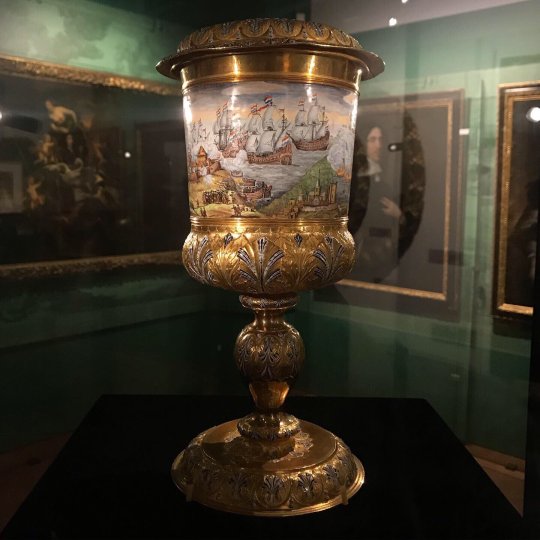
After the Raid on the Medway, Admiral Michiel de Ruyter, Admiral van Ghent and Cornelis de Witt each received a golden cup from the States of Holland (x)
The Dutch had taken up a position in the Thames by which they cut London off from trade. Coal supplies from the Tyne in particular were failing, and soon the price of coal increased tenfold. The English fleet was weakened by the raid and there was hardly any money available for its replenishment. King Charles II therefore had little choice but to instruct his envoys at the peace conference in Breda to conclude the treaty as soon as possible. The Peace of Breda was signed on 21 July 1667, and on 16 August the Dutch fleet abandoned the blockade of the English ports and the Thames estuary in accordance with the treaty. But England’s desire for revenge helped motivate another Anglo-Dutch War the following decade. But also an upgrade of the Navy as well as a change in the pay and living conditions of the Sailors which laid the foundation for one of the most powerful navies in the world.
#naval history#raid of the medway#12-14 june 1667#age of sail#event overview#and it is a very long post#sorry
40 notes
·
View notes
Text

Richard van Bleeck - Portrait of Sir John Holt - ca. 1700
oil on canvas, height: 124.5 cm (49 in) Edit this at Wikidata; width: 99.7 cm (39.2 in)
National Portrait Gallery, London, UK
Sir John Holt (23 December 1642 – 5 March 1710) was an English lawyer who served as Lord Chief Justice of England from 17 April 1689 to his death. He is frequently credited with playing a major role in ending the prosecution of witches in English law.
Historian John Callow argues in his 2022 book, The Last Witches of England, that sceptical jurists, especially Holt, had already largely stopped convictions for witchcraft under English law even before the Witchcraft Act 1735 finally concluded such prosecutions. Callow particularly credits Holt with great courage in doing so in the face of religious pressure, mob violence, and popular superstitious belief in witchcraft.
The Witchcraft Act 1735 (9 Geo. 2. c. 5) was an Act of the Parliament of the Kingdom of Great Britain in 1735 which made it a crime for a person to claim that any human being had magical powers or was guilty of practising witchcraft. With this, the law abolished the hunting and executions of witches in Great Britain. The maximum penalty set out by the Act was a year's imprisonment.
It thus marks the end point of the witch trials in the Early Modern period for Great Britain and the beginning of the "modern legal history of witchcraft", repealing the earlier Witchcraft Acts which were originally based in an intolerance toward practitioners of magic but became mired in contested Christian doctrine and superstitious witch-phobia. Instead of assuming as the earlier laws did that witches were real and had real magical power derived from pacts with Satan, the new law assumed that there were no real witches, no one had real magic power and those claiming such powers were cheaters extorting money from gullible people.
The law was reverting to the view of the primitive and the medieval Church, expressed from at least the 8th century, at the Council of Paderborn, but contested by witch-phobic Dominican Inquisitors beginning in the mid 15th century, with some success in forwarding a new doctrine among the popes, as seen in the papal bull Summis desiderantes affectibus (1484), but with far less success among the bishops. Thus the Act of 1735 reflected the general trend in Europe, where after a peak around 1600, and a series of outbursts in the late 17th century, witch-trials quickly subsided after 1700. The last person executed for witchcraft in Great Britain was Janet Horne in 1727.
In the early modern period, witch trials were seen between 1400 and 1782, where around 40,000 to 60,000 were killed due to suspicion that they were practicing witchcraft. These trials occurred primarily in Europe, and were particularly severe in some parts of the Holy Roman Empire. Some witch-hunts would last for years, and some sources estimate 100,000 trials occurred. Groundwork on the concept of witchcraft (a person's collaboration with the devil through the use of magic) was developed by Christian theologians as early as the 13th century. However, prosecutions for the practice of witchcraft reached a high point only from 1560 to 1630 during the Counter-Reformation and the European wars of religion, with some regions burning at the stake those who were convicted, of whom roughly 80% were women, mostly over the age of 40.
Richard van Bleeck (1670–1733) was a Dutch Golden Age painter.
19 notes
·
View notes
Text


On September *21st 1756 John McAdam, the surveyor who introduced the macadam system of road surfacing, was born in Ayr.
Sources will state 23rd September
The youngest of ten children, John was sent to the New World at the age of 14 upon the death of his father. There he teamed up with his affluent uncle William McAdam to run a prosperous mercantile business in the budding harbour town of New York.
As the business’s profits grew so did the reputations of John and William, and in 1772 William was named president of the New York Chamber of Commerce and John was elected Treasurer in 1774 at the age of 18. Mounting tensions between the Colonies and Britain darkened John’s bright future, and his fate was sealed with his marriage to Gloriana Nicoll.
The Nicoll family had been sent by King Charles II in the 1670s to claim the territory of New Netherlands on behalf of his brother, the Duke of York. Neither McAdam nor his bride was willing to betray the Nicoll proud heritage. When the revolution broke out John enlisted in a loyalist regiment and served as a British government contractor. After the defeat of the British Army, those who fought against the Colonies, including John McAdam and his wife, forfeited all property to the new American government. The couple was repatriated in 1783, where they bought a house in Ayrshire, Scotland.
Though McAdam and his wife had lost a fortune, their loyalty to the crown was rewarded and McAdam soon became a prominent public figure. While serving as Deputy-Lieutenant of his county, McAdam noted the horrible road conditions throughout Scotland and England. Most were uneven, dangerous to travel on and costly to repair. In response, McAdam invented a road system that was rivalled only by the road design of Thomas Telford.
Instead of digging out roadways, McAdam raised them to promote water run-off. Digging outflow ditches on each side further enhanced run-off, and the layering of different size stones created the elevated roadbed. Large stones were laid for the base followed by stones no larger than four ounces. McAdam had realized that loose stones would pack tightly under the weight of traffic and provide a stable, even ride
.Avoiding the introduction of clay, dirt, or sand on the road surface further enhanced stability. McAdam roads didn’t wash away, lasted longer, and handled any weight or size of vehicle, thus making contemporary regulations concerning vehicle size and weight irrelevant. Most of all, McAdam roads could be constructed at a fraction of the cost of more established road construction techniques. In 1801 McAdam accepted the post of surveyor to the Bristol Turnpike Trust. By 1818, he was a consulting surveyor for no fewer than 34 road trusts.
The growing demand for his methods prompted McAdam to write two books, The Present System of Road Making and Practical Essay on the Scientific Repair and Preservation of Roads. By 1923, the number of road trusts consulting McAdam had risen to 70, with many of them managed by one of his three sons.
McAdam was appointed Surveyor General of Metropolitan Roads in Great Britain in 1827, and in 1830 the French Government adopted the McAdam system of road construction. Prior to his death McAdam was offered a knighthood, which he declined because of failing health. His oldest son James accepted the honour in his place.
7 notes
·
View notes
Note
So, I'm trying to think of East Empire Company backgrounds that would make sense for a character, do you think they'd employ mercenary archeologists? With the old Imperial monopolies on Dwemer stuff for example, they'd need some kind of recovery agents to go down there and get the good stuff
YES...i'm certain that the company often brings in independent contractors for the more finicky excavations. (that would have been the next step if they'd found evidence of stalhrim in saarthal)
the east empire company is heavily based on the east india company and other monopolistic joint-stock enterprises of the preindustrial era. in its prime the east india company imposed martial law on india with its own standing army of well over 200,000 men—twice the size of britain's army—and went to war (literally) with its dutch competitors several times. by the 1670s king charles of england had passed a series of acts that gave the east india company the right to make "autonomous territorial acquisitions, to mint money, to command fortresses and troops and form alliances, to make war and peace, and to exercise both civil and criminal jurisdiction over the acquired areas." which is all just to say that
the east empire company is monstrous and terrifying
enough is going on in there that almost any character with any background or profession could feasibly be entangled in company business
15 notes
·
View notes
Text
I searched who led England the year our American house was built in 1698....William II and his cousin Queen Mary II


William III (William Henry; Dutch: Willem Hendrik; 4 November 1650 – 8 March 1702),[b] also widely known as William of Orange, was the sovereign Prince of Orange from birth, Stadtholder of Holland, Zeeland, Utrecht, Guelders, and Overijssel in the Dutch Republic from the 1670s, and King of England, Ireland, and Scotland from 1689 until his death in 1702. As King of Scotland, he is known as William II.[1] He is sometimes informally known as "King Billy" in Ireland and Scotland.[2] His victory at the Battle of the Boyne in 1690 is commemorated by Unionists, who display orange colours in his honour. He ruled Britain alongside his wife and cousin, Queen Mary II, and popular histories usually refer to their reign as that of "William and Mary".

2 notes
·
View notes
Note
Caucasians(people living near caucasus region?) Are white,right?
European ethnic groups. Not white so to speak.
White and black are both pseudoscience. There is no white people
1.The label “white” reflecting a group of humanity appears nowhere in law until 1681.
2.It first appears in an enactment passed by the Colonial Assembly of the Colony of Maryland
3.Virginia is significant because it was central to the invention of the white people
4.Burgess the site of Bacon’s rebellion in 1670s
5.1619 just over 20 Africans came from africa.Thousands of people were captured by Portuguese slave traders and their African allies such as the Imbangala, in invasions of the Kingdom of Ndongo (or "Angola") under Governor Luís Mendes de Vasconcellos. These were taken to port and often sent to other parts of the Spanish and Portuguese Empires, which were brought together in that time by the Iberian Union. Those taken captive from Angola may have belonged to the Ambundu ethnic group
6.1607-82 roughly 92,000 immigrants from Europe came into the colonies as chattel bond laborers.
7.Estimated 500 Africans in Virginia by 1650
8.Large number of were regularly bought and sold like horses in Virginia
9.Theodore Allen, landowners accumulating wealth from tobacco in 1620s Virginia transformed European tenants and wage laborers into “chattel bond servitude
10.European servitude in the tobacco fields of Virginia, claims Morgan, came closer to slavery than anything the British had ever seen
11.Well into the 19th century a married woman in the USA was unable to hold title to property in her own name, including property inherited or which was bequeathed to her, retain her own wages, enter into contracts, or to acquire custody of her children in the case of legal separation
12.North American colonial law largely replicated the common law of Great Britain
13.The alliance between European indentured servants and Africans (a mix of indentured, enslaved, and free blacks) disturbed the colonial upper class. They responded by hardening the racial caste of slavery in an attempt to divide the two races from subsequent united uprisings with the passage of the Virginia Slave Codes of 1705. While the farmers did not succeed in their initial goal of driving the Native Americans from Virginia, the rebellion resulted in Berkeley being recalled to England.
5 notes
·
View notes
Text

Gold Wedding Suit, 1673, English.
Worn by James, Duke of York.
Victoria and Albert Museum.
#james Duke of York#1673#wedding#1670s#1670s suit#1670s menswear#1670s England#17th century#1670s Britain#suit#menswear#English#England#known wearer#1670s wedding#gold#British#Britain#V&A
12 notes
·
View notes
Text

Portrait of Jane Monins in a blue and gold dress by John Michael Wright, 1670
282 notes
·
View notes
Text
Chateau de La Ferte Saint-Aubin. Part 2.
The Sitting Room. The paneling, floor and chimney date back to Louis XVI (late 18th century). The room includes an 18th century Persian carpet, a pair of gilded wooden consoles and furniture covered in Aubusson tapestries dating back to Louis XVI. The large mirror on the left has a medallion portrait of Marshal de la Ferte Senectere painted in 1670, with a portrait of Duchess de la Ferte Senectere, his second wife, painted by Mignard in the 17th century, facing it on the mirror above the chimney.The Billiard Room. This room was entirely redecorated by the O'Gormans around 1911. It had originally been a bedroom with 18th century paneling. The room has a beautiful set of neo-gothic furniture brought back from Britain by the O'Gormans, each piece featuring their arms and motto. The billiard table comes from the Chevillottess in Orleans.



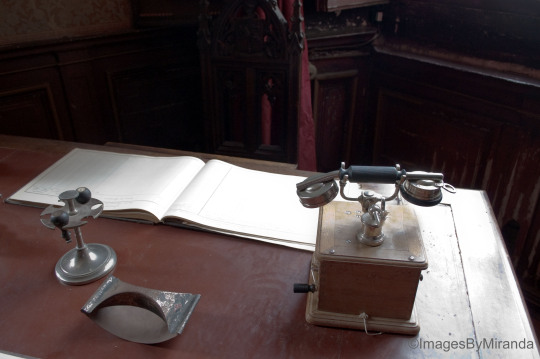
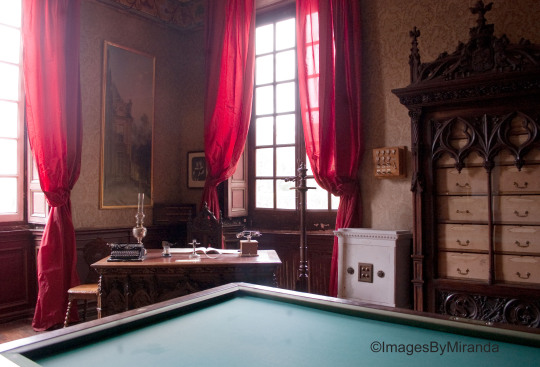
4 notes
·
View notes
Text
The Fusion and Innovation of Eastern Aesthetics in European Art
The Fusion and Innovation of Eastern Aesthetics in European Art
In the long history of European art, Eastern aesthetics serves as an undeniable thread, weaving together the mystery and splendor of the East with the artistic traditions of the West, thus creating a uniquely captivating artistic landscape. From ancient times to the present, Eastern culture and aesthetic principles have played a significant role in European art. The integration of Eastern aesthetics represents not only a cultural exchange but also a collision of ideas and a renewal of artistic forms. From the introduction of exotic treasures from the East to Europe, to the inspiration of Eastern painting styles on Western art, and further to the influence of Eastern decorative arts on European architecture and design, all demonstrate the profound impact of Eastern aesthetics on European art. This fusion is not merely about imitation or borrowing, but rather about the creation of new artistic forms and styles through mutual learning and absorption.
In 18th century England, China was perceived as a mysterious and distant land. Despite increasing trade between the two nations during the 17th and 18th centuries, access to China was still restricted, leaving people with very limited first-hand experiences of the country. It was within this context that Chinese-inspired decoration began to fully capitalize on these exotic and mysterious preconceptions. Various items featured fantastical landscapes such as pavilions and pagodas, distinctive Chinese-style roof shapes, elaborate birds, and figures dressed in traditional Chinese attire.

Thomas Chippendale's "The Gentleman and Cabinet-maker's Director"
During this period, publications such as William Halfpenny's "New Designs for Chinese Temples" (1750) and Thomas Chippendale's "The Gentleman and Cabinet-maker's Director" (1754) helped drive the production of Chinese-style furniture. "The Director" showcased a complete range of available furniture designs in the 18th century, along with the popular stylistic spectrum. Chippendale pioneered a distinctive Rococo style, blending Chinese and Gothic elements, where Chinese pavilions and pagodas were abstracted into delicate frameworks, combined with Rococo floral motifs, laying the groundwork for the "English" Rococo style.

Chinoiserie lacquer cabinet, housed in the V&A Museum
Starting from the 1670s, an increasing number of lacquerware items were imported from Asia to Europe. Merchants of the British East India Company worked diligently to ensure that Chinoiserie lacquer furniture could meet the demands of the domestic market. At this time in continental Europe, the prevailing artistic style was still Baroque. Inspired by Chinese lacquerware, artists and craftsmen created classic pieces that fused the local Baroque style with Chinoiserie influences.
Among the Chinoiserie furniture collected by the Victoria and Albert Museum in Britain, there is a cabinet made in 1688. It features a Chinese-style lacquered body and Baroque-style gilded table legs. This piece embodies both the extravagant decoration and mysterious aura of the East, as well as the weightiness and dynamic movement characteristic of Baroque art. Chinese motifs such as those found on hinges, floral and bird motifs, and landscapes with figures collide with Western motifs such as acanthus leaves and angels, creating a tension between the reserved and the flamboyant, as well as between the two- and three-dimensional representations of Eastern and Western beauty.
In the realm of jewelry, the fusion of exquisite Italian craftsmanship with Chinoiserie, represented by ChuCui Palace, stands out as a prime example. Chinoiserie, a European style influenced by Chinese art, began to emerge in the late 13th century and reached its peak in the mid-18th century. ChuCui Palace delves deeply into the essence of classic Eastern aesthetics within Chinoiserie and merges it with traditional Chinese fine brushwork and freehand painting, creating timeless masterpieces imbued with contemporary significance that lead the way in the modern Chinoiserie style.

ChuCui Palace "Dancing in Clouds" necklace
The necklace "Dancing in Clouds" by ChuCui Palace exemplifies the fusion of freehand painting from traditional Chinese art with Chinoiserie. Inspired by the classic Chinese cultural element of the crane, the piece emphasizes the sinuous lines inherited from the Rococo style within Chinoiserie, creating a strong sense of movement. The crane's neck and tail feathers are abstracted into simplified and delicate curves, outlining the magnificent decorative colors reminiscent of the East. These curves, delicate and graceful, interpret the abstract techniques of Chinese freehand painting while also portraying the ethereal grace of cranes in subjective imagery. The piece emulates the pure and elegant aesthetics of Chinese ink painting, primarily using diamond white and ink colors. The slender neck and plump tail feathers are juxtaposed, creating a tension between abstraction and realism, simplicity and complexity, and depicting the crane's demeanor as it tidies its feathers. Overall, the incorporation of movement, the use of curves, and the juxtaposition of abstraction and ink aesthetics from Chinese freehand painting within Chinoiserie create a classic masterpiece rich in historical significance while also capable of leading contemporary trends.
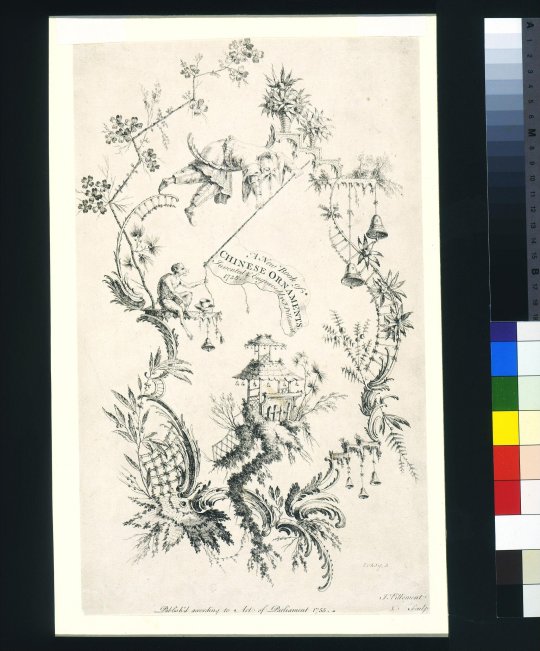
Chinoiserie sketches by the French painter Jean-Baptiste Pillement
In addition to furniture and jewelry, European artists also knew how to adapt traditional Chinese patterns into classic French Rococo decorative motifs. This print is the title page of "Nouveau Livre de Chinoiseries" (1755), by the French painter and designer Jean-Baptiste Pillement (1728-1808), marking the first pattern book dedicated to Chinese-inspired designs. The artwork showcases Pillement's ladder composed of curvilinear leaves, resembling the typical shapes of the French Rococo style, such as the letter 'C'. The piece is filled with fantastical colors and strong decorative elements, influenced by Eastern aesthetics. This Chinoiserie style, compared to the Baroque, demonstrates a better understanding of negative space, featuring delicate and lightweight foliage decorations, and achieving visual balance through asymmetrical compositions influenced by Eastern aesthetics.
The fusion and innovation of Eastern aesthetics in European art represent a transcendent artistic dialogue and integration across time and space. From ancient times to the present, the mystique and splendor of the East have continuously captivated the attention of European artists, inspiring them to create uniquely enchanting works. Whether in the fields of furniture, jewelry, or painting, Eastern aesthetics have injected new vitality and inspiration into European art. Through deep exploration and study of the essence of Eastern aesthetics, European artists have not only created new artistic forms and styles but also enriched the diversity and charm of European art. In future artistic endeavors, the cross-cultural exchange and integration of Eastern aesthetics with Western art will continue to be a challenging and innovative field, bringing forth more surprises and revelations to the art world.
1 note
·
View note
Text
Events 1.18 (before 1970)
474 – Seven-year-old Leo II succeeds his maternal grandfather Leo I as Byzantine emperor. He dies ten months later.
532 – Nika riots in Constantinople fail.
1126 – Emperor Huizong abdicates the Chinese throne in favour of his son Emperor Qinzong.
1486 – King Henry VII of England marries Elizabeth of York, daughter of Edward IV, uniting the House of Lancaster and the House of York.
1562 – Pope Pius IV reopens the Council of Trent for its third and final session.
1586 – The magnitude 7.9 Tenshō earthquake strikes Honshu, Japan, killing 8,000 people and triggering a tsunami.
1670 – Henry Morgan captures Panama.
1701 – Frederick I crowns himself King in Prussia in Königsberg.
1778 – James Cook is the first known European to discover the Hawaiian Islands, which he names the "Sandwich Islands".
1788 – The first elements of the First Fleet carrying 736 convicts from Great Britain to Australia arrive at Botany Bay.
1806 – Jan Willem Janssens surrenders the Dutch Cape Colony to the British.
1866 – Wesley College is established in Melbourne, Australia.
1871 – Wilhelm I of Germany is proclaimed Kaiser Wilhelm in the Hall of Mirrors of the Palace of Versailles (France) towards the end of the Franco-Prussian War. Wilhelm already had the title of German Emperor since the constitution of 1 January 1871, but he had hesitated to accept the title.
1886 – Modern field hockey is born with the formation of The Hockey Association in England.
1896 – An X-ray generating machine is exhibited for the first time by H. L. Smith.
1911 – Eugene B. Ely lands on the deck of the USS Pennsylvania anchored in San Francisco Bay, the first time an aircraft landed on a ship.
1913 – First Balkan War: A Greek flotilla defeats the Ottoman Navy in the Naval Battle of Lemnos, securing the islands of the Northern Aegean Sea for Greece.
1915 – Japan issues the "Twenty-One Demands" to the Republic of China in a bid to increase its power in East Asia.
1919 – World War I: The Paris Peace Conference opens in Versailles, France.
1919 – Ignacy Jan Paderewski becomes Prime Minister of the newly independent Poland.
1941 – World War II: British troops launch a general counter-offensive against Italian East Africa.
1943 – Warsaw Ghetto Uprising: The first uprising of Jews in the Warsaw Ghetto.
1945 – World War II: Liberation of Kraków, Poland by the Red Army.
1958 – Willie O'Ree, the first Black Canadian National Hockey League player, makes his NHL debut with the Boston Bruins.
1960 – Capital Airlines Flight 20 crashes into a farm in Charles City County, Virginia, killing all 50 aboard, the third fatal Capital Airlines crash in as many years.
1967 – Albert DeSalvo, the "Boston Strangler", is convicted of numerous crimes and is sentenced to life imprisonment.
1969 – United Airlines Flight 266 crashes into Santa Monica Bay killing all 32 passengers and six crew members.
1 note
·
View note